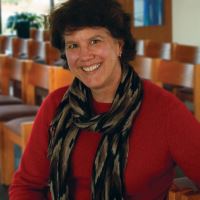Commentary on 1 John 1:1—2:2
Good News, Bad News
This text plays nicely with this week’s reading about Thomas and his desire to press his hands into the bloody wounds of Jesus.
It matters what our eyes have seen, what our ears have heard, what our hands and fingers have touched, because a flesh-and-blood world needs a flesh-and-blood savior.
Easter is a week behind us. The alleluias still ring in our ears, the joy of resurrection has been proclaimed through white lilies, soaring music, and maybe even a few leftover chocolate eggs and ham sandwiches. We have heard with our ears and seen with our eyes and touched with our hands this celebration of the empty tomb and a world forever changed by the resurrection of Jesus Christ.
At the same time, however, our ears ring with the world’s same old bad news. The joy of resurrection is flattened by political wrangling and the ongoing reality of home foreclosures and fruitless job searches, by despair and injustice and hearts broken open with jagged edges of grief. Is it not tempting to shut our eyes and our ears, to close our hands into fists of denial, to ignore those earthly realities?
Don’t we wish, at least for a moment, that the shining, bright holiness of a resurrected Christ would blind our eyes to the stains of this fleshy, painful world? Now that we walk in the light of Jesus, can’t we just ignore the sin around us and especially our own complicity in it? 1 John responds to these tempting questions with a resounding, “no!”
Two-part structure
The passage is readily divided into two sections (either of which could serve as a sermon focus) around a central thesis statement. Part one (verses 1-4) functions as a prologue to the whole book (similar to the prologue of the Gospel of John), and bolsters the author’s subsequent argument by claiming a first-hand experience of God’s revelation: “We declare to you what was from the beginning, what we have heard, what we have seen with our eyes, what we have looked at and touched with our hands, concerning the word of life” (1:1).
The thesis appears in verse 5: “This is the message we have heard from him and proclaim to you, that God is light and in him there is no darkness at all.” Part two (1:6-2:2) lays out the implications of this thesis in terms of our lives together (“if we walk in the light as he himself is in the light, we have fellowship with one another”, 1:7). To deny our own sin or the sin of the world is deceitful, and it proves that we are not walking in the light. But if we confess our sin we will be cleansed by the blood of Jesus (1:9).
Too Holy to be Earthly Good
The author of 1 John (called “John” because the language and theology of the letter — which is really more like an public essay than an epistle — closely correspond to the Gospel of John) is worried that his readers will be led astray by community members who have split off from the group (2:19).
Apparently, the secessionists have developed such a spiritualized view of Christ that the earthly, material reality of Jesus no longer matters much, nor do their own earthly, material actions. According to John, these people say they know Jesus but live as though they do not (2:4-6). They say they are in the light, but their actions suggest otherwise (2:9). They claim that they have no sin, but their claim is a lie (1:8).
In short, they talk the talk but do not walk the walk.
At stake for 1 John is not merely (merely!) right doctrine or proper belief. Rather, at stake is whether our actions testify to the truths we confess, whether our lives line up with our beliefs. In the view of 1 John, the truth is not simply something we think or believe, it is something we do. And the “doing” includes confession of sin. Why? Because that confession testifies to the truth that God “will forgive us our sins and cleanse us from all unrighteousness” (1:9-10). It opens our lives up to the “cleansing” of our actions, to new ways of being and doing.
Show us the body
The bottom line for 1 John is embodiment and incarnation. How do we know we walk in the light? The evidence is in our embodied relationships, that is, in our fellowship with and our love for one another (cf. 3:18). If we are doing the truth, then the community becomes a kind of incarnational evidence. If we sin, that, too, is manifested in community. What happens in the body matters, whether in the koinonia-body or in individual bodies (1:7).
One way to approach the sermon is to focus attention on embodiment: ours and Jesus’. 1 John claims that the eternal life that was with the Father has been revealed in a way that can be seen, heard, and touched (1:1-2). The blood from the body of Jesus cleanses the sins that are manifested in our individual and collective bodies, sins that can be seen, heard, and touched.
The message we have heard from God and we proclaim in our embodied communities is that Jesus does not save in an abstract way, but he saves us in our actual bodies. The risen Christ, incarnate as the flesh-and-blood Jesus, is the atoning sacrifice for our sins, and not for ours only but also for the sins of the whole world (2:2).

April 15, 2012